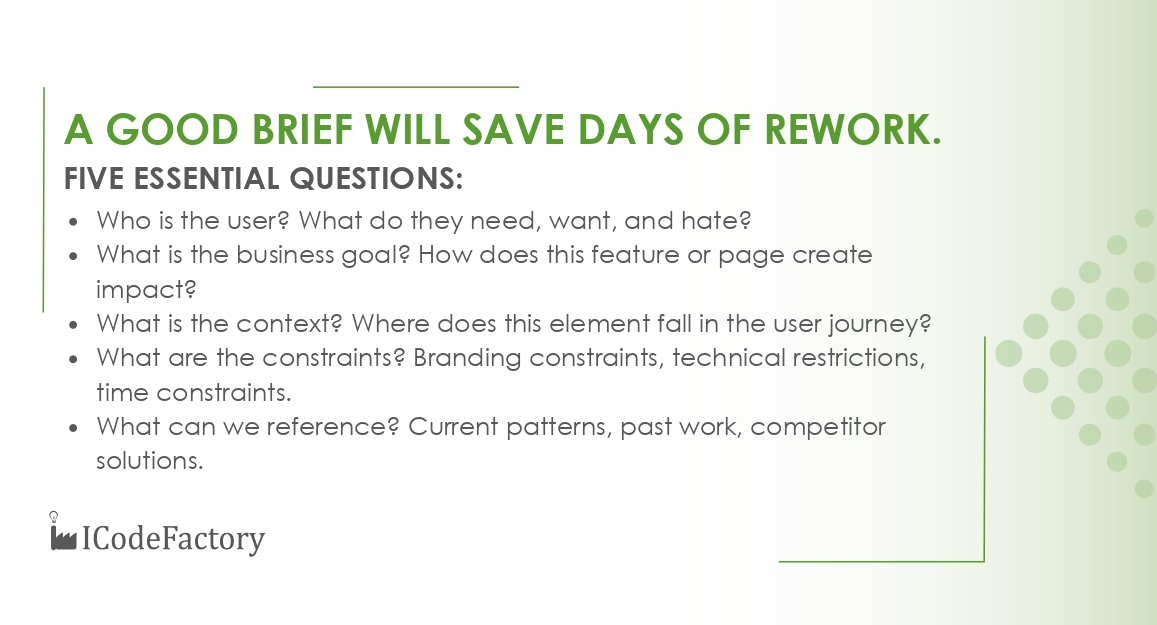Excellent design goes far beyond making things look attractive. Design is about solving the right problems in the right way. The greatness of a design starts long before mockups and wireframes, with the way we brief designers.
A good brief will save days of rework, minimize misunderstandings, and energize stronger products. Beyond the brief itself, however, there is something even more powerful and that is collective understanding in the team and with the client. Without such collective understanding, even the strongest ideas will prove inadequate.
A Brief Is Not Just a Task List: It Is a Bridge
Far too often, a design brief is reduced to one or two words:
- "Add filters to search."
- "Create a new onboarding flow."
- "Design a new page for the new product."
While these instructions describe what to do, they rarely explain why it matters. Effective design needs more than tasks; it needs context, clarity, and a shared purpose. A strong brief connects business goals, user needs, and design decisions.
It outlines why something needs to be created, for whom we are building it, what problem we are solving, and how the work fits in the big picture.
Without that connection, design risks becoming a “make it look nice” exercise instead of a strategic problem-solving process.
When designers understand the motivations behind business goals and user behaviors, they become active contributors rather than task executors. That’s when design moves from simply creating visuals to shaping meaningful solutions.
Understanding as a Business Advantage
From years of product development, we know that shared understanding is not a soft skill, it is a competitive edge.
Every unclear expectation at the start of a project can turn into days of redundant rework. Every missing detail in a brief can turn into misaligned features. Every "this is not what we had in mind" moment usually reduces to too little shared understanding.
In fact, Forbes shared that clear design frameworks (like detailed wireframes and flows) reduce ambiguity and back-and-forth by around 30%, leading to smoother and more cost-effective development. Moreover, according to a Hypersense report, fixing misunderstandings after delivery costs up to 100x more than clarifying them upfront. That is why we invest heavily in alignment from day one.
For example, if a client requests “a dashboard for reporting,” we could start designing right away. But without understanding who will use it, why they need it, and what success looks like, we risk creating something visually appealing but practically useless.
When the context is missing, good design fails to deliver business value.
That is why we challenge designers and clients to ask questions, question assumptions, and think of the big picture together. This sets the project up for success without delays.
How to Write a Brief That Works?
A good brief needs to be thoughtful. The goal to provide information and create a shared understanding between the business, designers, and other stakeholders. There are five essential questions we always cover before starting design:
- Who is the user? What do they need, want, and hate?
- What is the business goal? How does this feature or page create impact?
- What is the context? Where does this element fall in the user journey?
- What are the constraints? Branding constraints, technical restrictions, time constraints.
- What can we reference? Current patterns, past work, competitor solutions.
These insights allow designers to deliver solutions that are both beautiful and strategic, and generate business value.

The Client's Role in the Process
Great design is a collaborative process. We collaborate very closely with customers to fully understand their vision, challenges, and priorities.
We ask challenging questions, share early concepts, and validate assumptions with you. That early alignment eliminates surprises later and results in products that meet business goals and user needs.
Customers continuously tell us that they value designers as partners, not just implementers. And that partnership is based on trust, and trust is based on understanding.
In Conclusion - Better Briefs, Better Products
Design starts with understanding. A well-written brief creates alignment, reduces risk, and leads to better decision-making.
When all stakeholders, from clients to designers and teams, are aligned, products ship faster, collaboration works more effectively, and the final outcome offers more value to the business and to the user.
Ultimately, an amazing brief is about building knowledge. That's where amazing design begins.
